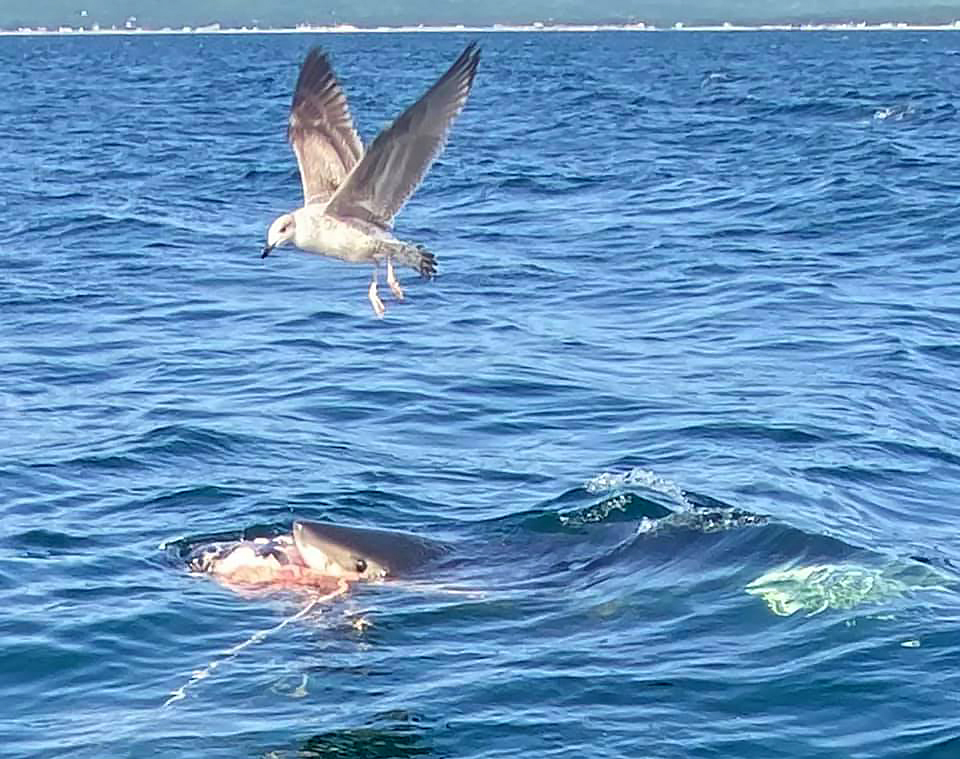A shark photographed nibbling and then vigorously chewing a seal carcass several kilometres off the Cape Breton, N.S., coast earlier this week has been identified by a marine biologist as a young great white.

The shark’s body shape, fin and size clearly visible in video shot by whale watchers helped confirm the species, Fred Whoriskey, a marine biologist at Dalhousie University and executive director of the Ocean Tracking Network, said in an interview Friday.
Monday’s sighting came several weeks after the RCMP said a 21-year-old woman suffered serious injuries in a suspected shark attack in waters near Margaree Island, off western Cape Breton – the opposite side of the island from the sighting this week.
Falyn Chiasson, a woman on the whale-watching tour who filmed the shark, said in an interview Friday it was thrilling to see the animal in its habitat but also unsettling given the recent suspected attack.
“It was mixed emotions,” she said. “There was the (suspected) shark attack off Margaree that was playing on my mind, and it was also playing on my mind that many never get a chance to see a great white in its natural habitat.”
The 28-year-old said she believes people in the area may have to be more vigilant about where they’re swimming and become educated about the potential presence of the large predators off Nova Scotia’s coast.
Whoriskey said there isn’t scientific consensus on whether the great white population is increasing in the northwest Atlantic, but there are tentative signs of more animals coming into the region, such as the increased sightings of young sharks by scientists and the public.
- Budget 2024 failed to spark ‘political reboot’ for Liberals, polling suggests
- Train goes up in flames while rolling through London, Ont. Here’s what we know
- Peel police chief met Sri Lankan officer a court says ‘participated’ in torture
- Wrong remains sent to ‘exhausted’ Canadian family after death on Cuba vacation
“We seem to be seeing a lot more young animals … and more juveniles indicates more recovery of the population,” the scientist said.
The species, he added, is listed as endangered in both Canada and the United States — meaning harvesting the animals is prohibited — which he said has likely helped the population of great whites recover in recent decades.
Whoriskey said underwater monitoring networks in the North Atlantic have been picking up signals of great white sharks over the past year in areas they weren’t detected in the past. “There are some places where we are putting out (acoustic) receivers where we’re getting as many as 19 great white sharks detected in a three-month period,” he said.
The researcher estimated that private and federal shark researchers have succeeded in tagging about 150 great white sharks that can be tracked when in the region.
‘We are the visitors’
He said one theory on the increased sightings of the young great whites is that they are travelling north for food instead of competing for meals with the larger number of sharks congregating off Massachusetts.
Whoriskey said there’s also been evidence of return migrations of the sharks to Nova Scotia. “It may be that once they find a place and they like it, they come back to it, growing bigger and bigger,” he said.
The scientist said it will be important to determine more formally whether the suspected attack off Margaree was a shark and what species it was. He said a group of experts who monitor shark attacks are hoping to receive information in order to make a more formal determination of what occurred.
Kinnon MacKinnon, who captains Keltic Express Zodiac Adventures in Ingonish, N.S., said when his Zodiac was near the great white on Monday, it appeared to show no fear of the 7.3-metre boat, adding that it swam beneath it several times.
“This is not our domain; we are the visitors,” he said. “I was vibrating at the end of it, as it was something we hadn’t witnessed before.”
This report by The Canadian Press was first published Aug. 27, 2021.








Comments